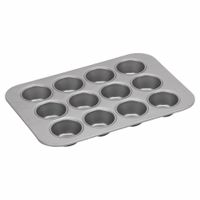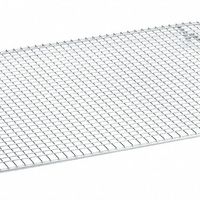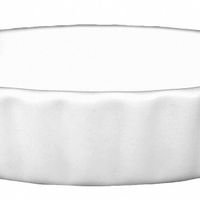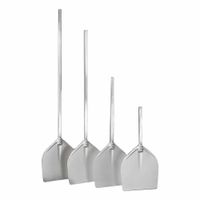Call +(254) 703 030 000 / 751 483 999 / 721 704 777
.....Read More
Frequently Asked Questions
What is the best material for a pizza stone?
The best material for a pizza stone is typically cordierite. Cordierite is favored for its excellent thermal shock resistance, meaning it can withstand rapid temperature changes without cracking. This is crucial for pizza stones, which are often subjected to high oven temperatures. Cordierite also has a high heat retention capacity, ensuring even cooking and a crispy crust.
Another popular material is ceramic. Ceramic pizza stones are known for their ability to distribute heat evenly, which helps in achieving a uniformly cooked pizza. However, they are more prone to cracking under thermal stress compared to cordierite.
Baking steel is another option, made from steel, which conducts heat more efficiently than stone. This results in faster cooking times and a crispier crust. However, baking steels are heavier and can be more challenging to handle.
Lastly, cast iron is also used for pizza stones. It heats up quickly and retains heat well, but like baking steel, it is heavy and requires maintenance to prevent rusting.
In summary, while each material has its advantages, cordierite is often considered the best overall due to its balance of heat retention, durability, and resistance to thermal shock.
How do you properly use a pizza paddle?
To properly use a pizza paddle, also known as a pizza peel, follow these steps:
1. **Preparation**: Lightly dust the surface of the paddle with flour, cornmeal, or semolina to prevent the dough from sticking. Ensure the paddle is dry and clean before use.
2. **Assembling the Pizza**: Place the rolled-out pizza dough onto the floured paddle. Add your desired toppings, ensuring they are evenly distributed and not too heavy, which can make transferring difficult.
3. **Checking for Stickiness**: Gently shake the paddle back and forth to ensure the pizza slides easily. If it sticks, lift the edges and add more flour or cornmeal underneath.
4. **Transferring to the Oven**: Open the oven and position the paddle at the back of the preheated pizza stone or baking surface. Use a quick, jerking motion to slide the pizza off the paddle. This is done by pulling the paddle back swiftly while giving a slight forward push to the pizza.
5. **Baking**: Close the oven and bake the pizza as per your recipe's instructions.
6. **Removing the Pizza**: Once baked, use the paddle to retrieve the pizza. Slide the edge of the paddle under the pizza, using a slight angle to lift it onto the paddle. Ensure the paddle is stable and the pizza is centered to prevent it from sliding off.
7. **Serving**: Transfer the pizza to a cutting board or serving tray. Clean the paddle after use, removing any residual flour or toppings.
By following these steps, you can efficiently use a pizza paddle to transfer pizzas to and from the oven, ensuring a well-cooked and intact pizza.
Can you cook pizza directly on an oven rack?
Yes, you can cook pizza directly on an oven rack, but there are some considerations to ensure the best results and avoid potential issues. Cooking pizza directly on the oven rack allows for better air circulation, which can result in a crispier crust. However, this method is best suited for frozen pizzas or pizzas with a firm crust that can support the toppings without sagging.
When cooking directly on the rack, preheat the oven to the temperature specified on the pizza packaging or recipe. Carefully place the pizza on the center rack to ensure even cooking. If the pizza is homemade or has a softer crust, consider using a pizza stone or baking sheet to provide additional support and prevent the dough from falling through the rack.
For fresh or homemade pizzas, using parchment paper can help transfer the pizza onto the rack and prevent sticking. However, ensure the parchment paper is rated for high temperatures to avoid burning. Alternatively, a pizza peel can be used to slide the pizza onto the rack.
Be cautious of toppings that may drip or fall off during cooking, as they can create a mess in the oven. To mitigate this, place a baking sheet on a lower rack to catch any drips.
After cooking, use a pizza peel or large spatula to remove the pizza from the oven. Allow it to cool slightly before slicing to prevent the toppings from sliding off.
In summary, while cooking pizza directly on an oven rack can enhance the crust's texture, it requires careful handling and consideration of the pizza's structure and toppings to avoid potential issues.
What is the difference between a pizza stone and a pizza steel?
A pizza stone and a pizza steel are both tools used to bake pizza, but they differ in material, heat retention, and performance.
**Material:**
- **Pizza Stone:** Typically made from ceramic, cordierite, or other natural stones. These materials are porous, which helps absorb moisture from the dough, resulting in a crisp crust.
- **Pizza Steel:** Made from solid steel, usually carbon steel. It is non-porous and heavier than a stone.
**Heat Retention and Conductivity:**
- **Pizza Stone:** Stones heat up slowly and retain heat well, providing even cooking. However, they are less efficient in transferring heat compared to steel.
- **Pizza Steel:** Steels heat up faster and have superior heat conductivity, which allows them to transfer heat more quickly to the pizza, resulting in a faster cook time and potentially crispier crust.
**Durability:**
- **Pizza Stone:** More fragile and prone to cracking, especially with thermal shock (sudden temperature changes).
- **Pizza Steel:** Extremely durable and resistant to cracking or breaking. It can withstand high temperatures and thermal shock.
**Maintenance:**
- **Pizza Stone:** Requires careful handling and cleaning. It should not be washed with soap as it can absorb odors.
- **Pizza Steel:** Easier to clean and maintain. It can be seasoned like cast iron to prevent rusting.
**Performance:**
- **Pizza Stone:** Provides a traditional baking experience with a focus on even heat distribution.
- **Pizza Steel:** Offers a modern approach with faster cooking times and a crispier crust due to its superior heat transfer capabilities.
In summary, a pizza stone is ideal for those seeking traditional baking with even heat, while a pizza steel is preferred for faster cooking and a crispier crust.
How do you clean a pizza stone?
1. **Cool Down**: Allow the pizza stone to cool completely in the oven to prevent cracking from temperature shock.
2. **Remove Debris**: Use a plastic spatula or bench scraper to gently remove any stuck-on food particles.
3. **Wipe with Water**: Dampen a clean cloth or sponge with warm water and wipe the surface of the stone. Avoid using soap as it can be absorbed by the porous stone and affect the taste of future pizzas.
4. **Scrub Stubborn Spots**: For tougher stains or baked-on residue, make a paste of baking soda and water. Apply it to the stained areas and gently scrub with a brush or non-abrasive pad.
5. **Rinse and Dry**: Wipe the stone with a clean, damp cloth to remove any baking soda residue. Allow the stone to air dry completely before storing or using it again.
6. **Avoid Soaking**: Never soak the stone in water as it can absorb moisture and crack during the next use.
7. **Regular Maintenance**: Over time, the stone will develop a natural patina that enhances its non-stick properties. Regular cleaning with just water and occasional baking soda scrubbing is sufficient.
8. **Storage**: Store the stone in a dry place. If storing in the oven, ensure it’s clean and free of any food particles.
9. **Avoid Oils**: Do not apply oils or grease to the stone as it can cause smoking and odors during cooking.
10. **Preventive Care**: Use parchment paper or a pizza peel to transfer pizzas to minimize mess and reduce cleaning needs.
What size pizza paddle should I buy?
To choose the right size pizza paddle, consider the following factors:
1. **Pizza Size**: Determine the size of the pizzas you typically make. The paddle should be slightly larger than the largest pizza you plan to handle. Common paddle sizes range from 12 to 16 inches in width.
2. **Oven Size**: Ensure the paddle fits comfortably in your oven. Measure the oven's interior to avoid a paddle that's too large to maneuver.
3. **Material**: Paddles come in wood, metal, and composite materials. Wood paddles are traditional and prevent sticking, while metal paddles are thinner and easier to slide under the pizza.
4. **Handle Length**: Consider the depth of your oven and your comfort level. Longer handles are useful for deep ovens or outdoor pizza ovens, while shorter handles are suitable for home ovens.
5. **Storage Space**: Ensure you have enough space to store the paddle. If space is limited, consider a paddle with a detachable or foldable handle.
6. **Frequency of Use**: If you make pizza frequently, invest in a durable, high-quality paddle. For occasional use, a basic model may suffice.
7. **Skill Level**: Beginners might prefer a larger paddle for easier handling, while experienced users might opt for a smaller, more maneuverable paddle.
8. **Budget**: Prices vary based on material and brand. Set a budget that aligns with your needs and frequency of use.
By considering these factors, you can select a pizza paddle that suits your specific needs and enhances your pizza-making experience.
Can you use a baking sheet as a pizza stone?
Yes, you can use a baking sheet as a substitute for a pizza stone, but there are some differences to consider. A pizza stone is designed to absorb moisture and distribute heat evenly, resulting in a crispy crust. Baking sheets, typically made of metal, do not have the same heat retention or moisture-absorbing properties.
To use a baking sheet effectively, preheat it in the oven to mimic the heat retention of a pizza stone. Place the baking sheet upside down in the oven while it preheats to the desired temperature, usually around 475°F (245°C). This allows the pizza to slide off easily and ensures even cooking.
When ready, carefully transfer the pizza onto the hot baking sheet using parchment paper or a pizza peel. The preheated sheet will help crisp the crust, though it may not achieve the same texture as a pizza stone.
Keep in mind that baking sheets may warp under high heat, and the crust might not be as evenly cooked as with a stone. However, using a baking sheet is a convenient and effective alternative for those without a pizza stone.



